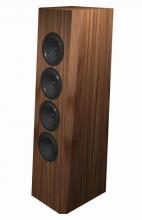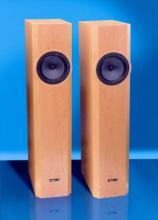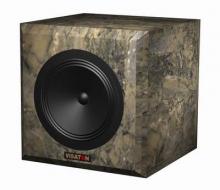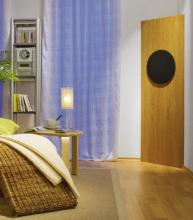Fullrange Systems
GRAND ORGUE
The toughest challenge for a high-end loudspeaker is to reproduce the lowest frequencies of larger instruments, such as an organ or double bass, with appropriate fidelity. Only very few speakers are at all able to reproduce the lowest register of a church organ and even then only the very best are able to make it sound as if it was coming from an organ pipe. To do credit to a double bass in all its glory without sounding fluffy or over-inflated or, even worse, giving up altogether, is the reserve of very few, outstanding loudspeaker constructions. The "Les Orgues" speaker series, in this case the GRAND ORGUE species, represent exactly that capability. With eight WS 25 E - 8 Ohm woofers, optimised specifically as a free-air system, mounted in a folded, but open baffle, they are able to reproduce bass down to below 20 Hz in a most natural, unhurried and completely unexaggerated manner and with no sign of weakness. Since there is, in effect, no enclosure, the resonant frequency of the woofer is not increased, but in this case even decreased, which enables it to emanate clear, non-compressed extremely low frequencies. The precondition for this low-range bass imaging, which uses double-sided radiation, is, however, also to ensure the speakers are far enough away from the wall. One metre is sufficient, but for full power right to the bottom of the bass range, 2 - 3 metres is preferable.
But the effortless and unobtrusive deep bass is not all, by any means. The bass section, which radiates to both sides, is supplemented by a line array consisting of eight oval SL 713 - 4 Ohm full-range drivers. This moderately priced full-range loudspeaker is characterised by its extremely light paper diaphragm and the voice coil carrier made of kraft paper which, together, ensure absolutely natural sound right through to the highest frequencies.
A key characteristic of line arrays is that they generate a highly focused sound beam in the vertical plane. Outside that main path, a large proportion of the signal is cancelled out by interference. This prevents reflections from the floor and ceiling from even coming into existence, which would impair the precise tridimensional imaging of the music. However this beaming effect is a direct function of the wavelength of the sound radiated. The higher the frequency, and, as a result, the shorter the wavelength, the more extreme the beaming effect. A large array such as we have here in the GRAND ORGUE would normally lead to very extreme beaming in the high-frequency range, which would not reflect the reality of the sound being played. To achieve as uniform a beaming effect as possible across the entire frequency range, which is important to guarantee balanced sound quality in the listening room, we have arranged for a correcting circuit within the array. This circuit ensures that, as the frequency increases, additional output is directed towards the second and third full-range drivers from the top while the output to the other six drivers is gradually reduced. In effect, the array is shortened across the full range steplessly from eight loudspeakers to two. These two loudspeakers should be as close as possible to ear height. If ear height should actually be higher or lower than the midpoint between the second and third full-range drivers from the top, the system can easily be adapted to the situation by wiring up the array in such a way that e.g. the third and fourth drivers from the top are responsible for the higher frequencies. In this way, the cabinet can be tuned in small steps to suit the real situation.
Combining all these technical sophistications in a single cabinet results in an exceptional speaker system which is predestined for the "natural" reproduction of music, but not only for that. Whether it is a keenly picked guitar string, a crisp drum solo, an entire symphony orchestra including an uplifting, heart-warming string section and a powerful brass department, or the veritable queen of all instruments, the organ, it will all come across absolutely authentically, with dynamism and is guaranteed to give you goose pimples. In the same way, voices, male and female, are reproduced faithfully including every tiny detail. Each instrument and voice appear to be hovering in exactly the right place in space, the spatial quality is completely natural and everything is in the defined position.
Anyone on the lookout for loudspeakers for high-quality music, who does not intend to make compromises in terms of frequency response and who is keen on extremely accurate imaging of the stage or orchestra pit, should take a close look at the GRAND ORGUE. The only preconditions are a powerful amplifier and generous distances between the cabinets and the walls to enable the GRAND ORGUE to develop its capabilities.
HINT: The bass part of the GRAND ORGUE, on its own without the full-range drivers, connected directly up to an active source without a passive crossover, acts as an excellent subwoofer and can be used, either singly or as a pair, to support music-orientated high-end loudspeakers and full-range loudspeakers down to the lowest bass frequencies and give home theatres the bottom end that they deserve.
PENTATON BB
Full-range loudspeakers are enjoying another comeback and arousing increased interest, embodying, as they do, everything that a point soundsource should be. Large full-range loudspeakers like the B 200 - 6 Ohmhave the additional characteristic of transmitting the sound in a tightly bundled beam, which produces a very tangible, three-dimensional effect and allows individual instruments to be easily located. A drawback of the system, however, is that this beaming process and the sensitivity are reduced at lower frequencies. The PENTATON BB was developed specifically as a cabinet based on the legendary B 200 - 6 Ohm but designed to compensate for these two disadvantages.
In a similar way to the QUADRO, additional full-range drivers are switched in to supplement the central driver, which is connected direct to the amplifier without an intervening filter, as the frequencies go down the scale. This allows the B 200 - 6 Ohm to develop its full potential with none of the impairments caused by frequency-dependent signal-carrying components, while the BG 20 - 8 Ohms, that are optimised for low-frequency response, maintain the extremely high sensitivity and beaming effect right down to the bass range. The additional full-range drivers are arranged symmetrically in two groups around the main speaker, which again creates an acoustic focus in the centre of the speaker cabinet. On top of this, the baffles in enclosures 2 and 4 and in enclosures 1 and 5 are angled inwards by 6° and 12° respectively. This feature guarantees that, assuming a typical listening distance of approx. 3 m, each of the drivers is exactly the same distance away from the ear and at the same angle. Given the size of these speaker cabinets, this is the only way to ensure that the phases of all the drivers are in sync across the entire frequency range.
The result of all these characteristics taken together is a sound image of the stage that could hardly be clearer or more precise. Even baritone male voices and large instruments such as the double bass or bassoon appear to be present full-size, in the right place on the virtual stage and in tangible 3D. Thanks to the enormous diaphragm area and the low moving mass, the PENTATON BB transforms dynamic jumps in the recording decisively and seamlessly into sound pressure and, with its superior handling, encourages the listener to increase the volume level until it is physically felt and yet it never becomes obtrusive or laboured.
And yet, this is definitely a speaker for connoisseurs of lower volumes. Even at low output levels, the overall sound quality is tangible and mature so that every tiny musical detail, however small, is projected audibly without the slightest distortion. The frequency response is remarkably linear for a loudspeaker of this kind, which is why the PENTATON BB is ideal for the authentic reproduction of every genre of music without restriction and will allow the listener to rediscover even old favourites thanks to its analytical and highly detailed approach.
Thanks to its high sensitivity and uniform impedance curve, the PENTATON BB is predestined for use in connection with high-grade tube amplifiers with relatively low output wattages.
PETIT ORGUE
The toughest challenge for a high-end loudspeaker is to reproduce the lowest frequencies of larger instruments, such as an organ or double bass, with appropriate fidelity. Only very few speakers are at all able to reproduce the lowest register of a church organ and even then only the very best are able to make it sound as if it was coming from an organ pipe. To do credit to a double bass in all its glory without sounding fluffy or over-inflated or, even worse, giving up altogether, is the reserve of very few, outstanding loudspeaker constructions. The "Les Orgues" speaker series, in this case the "Petit Orgue" species, represent exactly that capability. With their WS 25 E - 8 Ohm woofers, optimised specifically as a free-air system, mounted in a folded, but open baffle, they are able to reproduce bass down to below 20 Hz in a most natural, unhurried and completely unexaggerated manner and with no sign of weakness. Since there is, in effect, no enclosure, the resonant frequency of the woofer is not increased, which enables it to emanate clear, non-compressed extremely low frequencies.
In contrast to conventional loudspeaker cabinets in which it is the sheer size that determines, to a large extent, their capability to produce very low frequencies, the "Petit Orgue" can indeed compete with its big brother, the "Grand Orgue", in terms of depth. The differences between them are limited, in the main, to the sensitivity and maximum volume level, while the lower limiting frequency is identical. You have to actually hear with your own ears how this unassuming little speaker pumps those deep-black sound waves around the listening room before you can believe it. It may be that the maximum volume level is restricted, but the very fact that it is able to produce lower bass frequencies than most of the larger column speakers is more than impressive.
The precondition for this low-range bass imaging, which uses double-sided radiation, is, however, to ensure the speakers are far enough away from the wall. One metre is sufficient, but for full power right to the bottom of the bass range, 2 - 3 metres is preferable. It is, therefore, not really feasible to use the "Petit Orgue" as a shelf-mounted solution, despite its modest size.
As in the big brother, oval SL 713 - 4 Ohm full-range drivers are responsible for the range above 300 Hz. This moderately priced full-range loudspeaker is characterised by its extremely light paper diaphragm and the voice coil carrier made of kraft paper which, together, ensure absolutely natural sound right through to the highest frequencies. Since only two of them are in use here, there is no need for separate controllers. It is a good idea, however, to use suitable stands to raise the "Petit Orgue" speakers to ear height because the two full-rangeloudspeakers radiate their output as a beam.
The tonality of these speakers is comparable to that of the "Grand Orgue": highly authentic, direct, dynamic. The bass is incredibly deep and yet retains unobtrusive clarity. With the "Petit Orgue", low-frequency instruments, powerful orchestral moments and voices come across absolutely authentically and with a large portion of live atmosphere. The image of the orchestral layout is clearly defined and focussed, even if, as a result of the construction principle, it cannot quite reproduce the exceptional precision of which the "Grand Orgue" with its 8-fold array is capable.
Be that as it may, the "Petit Orgue" is far more than just a baby brother. It is indeed a fully-fledged high-end loudspeaker system that is designed to appeal to listeners who may not need absolute top-of the range volume levels but who do require deep black crisp bass and extremely authentic instrument layout.
Hint: The bass part of the "Petit Orgue", on its own without the full-rangedrivers, connected direct up to an active source without a passive crossover, acts as an excellent subwoofer and can be used, either singly or as a pair, to support music-orientated high-end loudspeakers and full-range loudspeakers down to the lowest bass frequencies.
QUADRO
When the QUADRO was developed, the primary objective was to produce a loudspeaker with a very high sensitivity rating because the trend in recent times has been a retrograde one towards high-end tube amplifiers. However, these are often restricted to very low outputs of only a few watts. There are plenty of loudspeaker constructions which promise extremely high volume levels with only one watt but, on closer examination, are seen to produce that level only at medium and high frequencies. Extending the high sensitivity level to include low frequencies is indeed a challenge. To achieve that aim, it is crucial to include a very large diaphragm area which, in turn, requires a large sized cabinet if one wants decent bass volumes.
The generously sized enclosed QUADRO cabinet provides sufficient space for four of the excellent B 200 - 6 OHM full-range loudspeakers to ensure that, even at the lower end of the bass frequency range, there is plenty of cone excursion. The drivers are closely bunched one above the other, which provides for an excellent radiation pattern: a broad angle in the horizontal plane and a relatively tightly bundled beam to top and bottom. To prevent the bundling effect becoming too strong in the vertical, all the drivers are powered in parallel in the bass frequencies and, as the frequency increases, the B 200 - 6 OHM 's are phased out one after another so that, at very high frequencies, only the second driver from the bottom is working. The slightly tilted front baffle means that this full-range loudspeaker is then aimed directly at ear height, assuming one is seated at least 3 metres from the speakers.
Anyone with experience of the sound properties produced by the SOLO or SOLITUDE speakers will have a fairly clear idea of the clarity of soundproduced by the QUADRO. These qualities are, however, boosted by the fact that the air in the room is set in motion by a large diaphragm area but that force is hardly aimed at the floor or ceiling at all. A noticeable feature of the QUADRO are its clarity and analytical qualities, while, at the same time, not becoming obtrusive. The QUADRO may not be able to match the extremely deep bass output levels of the SOLITUDE, for example, but that is in fact a positive feature in rooms that are not so large because the reverberating room resonance frequencies are not stimulated at all. However, the physically tangible kick-bass effect, a feature expected from musicians' speakers, can indeed be produced if the amplifier is powerful enough. In addition, the QUADRO shows its strengths in the faithful reproduction of voices and recordings of large orchestras. It is fair to say, then that this is a good, all-round high-end loudspeaker.
SOLITUDE
The SOLITUDE set-up combines the direct, highly precise soundreproduction of the B 200 - 6 Ohm wide-range speaker with the dynamic bass of two GF 200 - 2 x 4 Ohm. The B 200 - 6 Ohm is fitted in a completely enclosed, heavily damped compartment. The two GF 200 - 2 x 4 Ohm woofers are mounted in a voluminous cabinet with a generously dimensioned bass reflex tube. Owing to the very low-frequency separation, SOLITUDE is, in effect, a wide-range speaker with a subwoofer.
First impressions: fantastic sound! A synthesis of the precision localisation, clarity and analytical precision of the SOLO 100 or SOLO 50(straight down the axis) and the level accuracy of the CONCORDE MK III. The bass is deep but not heavy, the medium range clearly evident, with no fuzzy fringes. We could not detect a break between the bass and the rest - the sound was more homogeneous and pure than we had ever heard from any other wide-range speakers.
The two sections have to be reverse connected. In so doing, it does not matter whether the bass is connected correctly or not as long as the SOLITUDE is playing on its own. In conjunction with other speakers (e.g. in a multichannel system) the bass must, of course be in sync.
SOLO 100
The B 200 - 6 Ohm was fitted in a narrow column speaker with a net volume of around 100 litres. Due to the high Q-factor, one would normally have a relatively strong increase in reverberation response at around 60 Hz in a normal enclosed chamber or bass reflex cabinet. To prevent this, and indeed to take full advantage of the bass reflex principle, we thought up this little arrangement which, to our knowledge, has not been done before.
The chamber is split into two equal parts by a separator. On the rear wall, we built a vertical tunnel as a Helmholtz resonator which was tuned exactly to the frequency of the increase. This tunnel was then loosely filled with a packing of wool. In its undamped state, this resonator absorbs just the amount of the increase and even causes a slight dip in this range. You can vary the amount of packing used to achieve the required frequency response. In this way, we managed to ensure that the bass reflex did not produce overpowering bass despite the bass reflex tuning.
In keeping with the frequency response so typical of wide-range speakers with increasing medium- and top-range frequencies, this speaker, too, has an unacceptably high-pitched sound. So we applied a passive correction circuit (five simple components) to smooth off the frequency response in a very simple but effective manner for a full-range loudspeaker. Depending on the acoustics in the room and personal preference, the 15 ohm series resistance can be changed. Reducing it to 10 ohms will result in an increase in the high-frequency range, while increasing it to 22 ohms will dampen the treble more effectively.
SOLO 20
The smallest member of the SOLO family with its high-end B 200 - 6 Ohmfull-range loudspeaker has an inside capacity of only 20 l. The lower limiting frequency is at 52 Hz (-10 dB) and 65 Hz (-6 dB).
The correcting circuit for making producing a linear volume increase in the B 200 - 6 Ohm can be made even more simply in the SOLO 20. All we need is three components. There is also an linearisation of the impedance which means that the SOLO 20 can also be connected up without problems to amplifiers with a low attenuation factor.
The compact design enables these speakers to be placed unobtrusively on a sideboard or in a shelving unit or to be mounted on their own stands. If a powerful subwoofer for the low-range frequencies is integrated, the user has a system which provides enough flexibility to deal with even difficult acoustics in many rooms by careful positioning and adjustment of the output levels.
The SOLO 20 is also highly suited to home theatre applications. The speakers can be used for all the channels and should be supported at the lower end by a subwoofer.
In terms of its sound qualities, the SOLO 20 provides all the positive properties of its larger cousins, the SOLO 50 or SOLO 100, as regards sound source, transparency and analytical clarity. Add to this the increased, robust output stability due to the fact that the B 200 - 6 Ohm is relieved of the bass frequencies.
- No longer available -
SOLO 50
The SOLO 50 applies the SOLO 100 concept to a more compact cabinet. This makes the units suitable for smaller rooms where the larger version would be too physically overpowering or the bass too powerful.
With a net volume of 50 litres, it is essential to have an internal resonance absorber as with the SOLO 100 owing to the Q-factor of the B 200 - 6 Ohm. This can also be used to fine-tune the bass reflex. The lower limiting frequency is not as low as with the SOLO 100 but is certainly sufficient for small to medium-sized rooms. The absorber must be carefully damped again.
The correcting circuitry is designed by analogy to the SOLO 100. If you replace the 15 ohm resistance with a 22 ohm, the increase in high-frequency frequency response will be eliminated and the result as measured in the measuring room was a well-balanced spectrum. Listening tests showed, however, that, as a result of the beaming effect of this wide-range speaker, a slight increase is beneficial in most listening environments.
SOLO Eckbox
It is a physical characteristic of all wide-range high-sensitivity loudspeakers, and that includes the high-end B 200 - 6 OHM speaker, that they reproduce higher frequencies louder than the lower ones. To compensate for this, we have designed speaker cabinets for the corners of the room. Corners tend to boost the bass but not the higher frequencies. This allows us to use a very simple correcting circuit (consisting of a coil and a resistance) and we still get a very pleasing, natural overall sound.
With relatively little effort, it is possible to produce efficient, high-end speaker cabinets with excellent sound properties which also fit in optically. If you want to, you can even make them blend in completely or almost disappear by wallpapering them the same as the walls or painting them the same. The shape can even be adapted to take full advantage of the height of the room, for example. What matters is that the inside volume is kept the same.
A complete kit for this suggestion is available via www.vc-mailorderservice.de.
STELLA LIGHT
To be clear from the start: these small sized STELLA LIGHT speakers pack a considerable punch. While the outer appearance of the speakers might be described as compact or even sweet, this definitely does not apply to the maximum sound pressure of which they are capable. The combination of universal full-range FRS 8 - 8 Ohm loudspeaker and W 170 S - 8 Ohm woofer stands out because of its unbelievable level accuracy.
The fact that the separating frequency is at a very low 200 Hz benefits the STELLA LIGHT's positioning accuracy and generates an image of the stage that easily earns the "live" label. The FRS 8 - 8 Ohm full-range loudspeaker is remarkably detailed in its output: even the higher frequencies are reproduced accurately and with clear focus. Complemented by the W 170 S - 8 Ohm woofer, this combination covers almost the full range of frequencies required.
Whether used as computer speakers to the left and right of the desk or as a stereo set for the sitting room or bedroom, thanks to the excellent value-for-money price, these speakers can be used universally in many different environments without making too large inroads into your wallet. The simple, effective and intriguingly designed series crossover rounds the system off to produce a low-priced, quality building kit.
After all the cables have been positioned in the cabinet, the cable opening in the divider will have to be sealed off with e.g. hot-melt glue.






